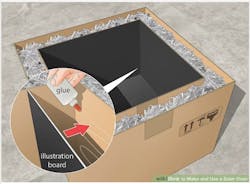For those readers who are totally committed to slashing their personal carbon footprints, here’s a way to enjoy a nearly carbon-neutral, guilt-free, green Thanksgiving dinner. You will need some materials and some DIY skills to make this happen. So let’s start with the materials. (Note that all dimensions are approximate; the ratios are more important than the actual dimensions).
You’ll need a single sheet of corrugated cardboard, approximately 30-in. x 22-in.; two cardboard boxes, 24-in. x 16-in. x 8-in. and 22-in. x 14-in. x 6-in.; a piece of clear, single-panel glass, 24-in. x 16-in.; a piece of sheet metal, cut to fit snugly inside the 22x14 box; a 60-ft roll of aluminum foil; feathers and/or rice hulls (and crumpled-up newspapers from the recycle bin, if you have them); no-VOC black spray paint (such as Krylon or RustOleum); nontoxic, water-based glue (e.g., Elmers); no-VOC silicone or silicone-replacement caulk (AFM, DuraSil, etc.); an eco-friendly paintbrush (i.e., bamboo handles and vegan – typically corn fiber – bristles; a utility knife; four (4) wooden clothes pins; an unpainted metal clothes hanger; and a pencil and yard stick. By now, I’m sure you’ve figured out that we’re making... a solar oven!
Step 1, cut a 22x14 opening in the center of the bottom of the 24x16 box (this is the outer box).
Step 2, draw fold lines 6-in. from the edges on the 30x22 sheet of cardboard (this will be the lid) and cut a 22x14x14 tab in the center of it. Fold up the tab and trim the flaps of the 22x14 box (this is the inner box), so they’re the same width as the “window frame” on the bottom of the outer box.
Step 3, apply glue around the inside of the “window frame” in the bottom of the outer box, and press the upside down inner box (i.e., top first) into the outer box. Allow the glue to dry.
Step 4, glue aluminum foil to completely cover the outside bottom and walls of the inner box, and fill the space between the boxes with feathers, rice, and crumpled newspaper to act as insulation. Close the outer box flaps and glue them shut.
Step 5, dilute the glue with water and use the paintbrush to spread a thin layer of glue on the dull side of sheets of aluminum foil. These sheets will be smoothly attached to the inside surfaces of the inner box. Allow the glue to dry.
Step 6, glue aluminum foil to the bottom of the tab in the lid. With the lid upside down (foil facing up), score the fold line, cut the corners, fold the edges up, and glue the corners. Use the clothes pins to clamp the corners until the glue is dry.
Step 7, spread the caulk around the foil in the lid and insert the glass. Ensure that the glass makes good contact with the caulk, and let it thoroughly cure/dry.
Step 8, paint the piece of sheet metal black and, while it’s drying, straighten out the hanger, cut to size, and bend the ends to fit into corrugations in the side of the tab and the lid. This will be used to prop the tab at the right angle when the lid is placed on the inner box.
Step 9, put the metal piece in the bottom of the inner box, place a black cooking pot and lid (no more than 6-in. high) on top of the metal piece, and place the lid on top. Adjust the tab for maximum solar reflection and you’re ready to cook.
Of course, you won’t be able to cook a real turkey in it, nor would you probably want to, since raising and processing turkey actually results in significant carbon emissions. According to greeneatz.com, the carbon footprint for 1 kg of turkey is 10.9 kg CO2e. So a 5 lb. turkey has a carbon footprint equivalent to 55 lb. of CO2 (that’s the equivalent of charging your smartphone every day for nearly nine years). There are plant-based turkey substitutes available, but I won’t comment on them, since I’m 'old school' when it comes to an oven-roasted turkey!
Whatever you choose to do for dinner, I wish you all a Happy Thanksgiving with family and friends!
P.S. Although this was a bit tongue-in-cheek, if you followed the directions you actually built a working solar oven. This is not a toy, and unattended children should not be allowed near it!
A regular contributor to HPAC Engineering and a member of its editorial advisory board, the author is a principal at Sustainable Performance Solutions LLC, a south Florida-based engineering firm focusing on energy and sustainability. He can be reached at [email protected].












